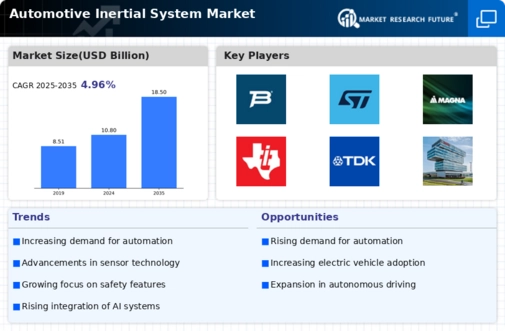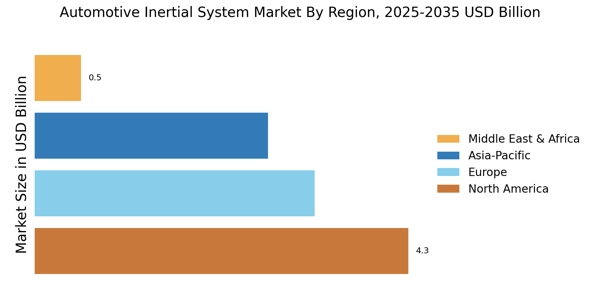Increasing Adoption of Electric Vehicles
The increasing adoption of electric vehicles (EVs) is a significant driver for the Automotive Inertial System Market. As the automotive landscape shifts towards electrification, the need for advanced inertial systems that can support the unique dynamics of EVs becomes evident. These systems are essential for optimizing battery performance and enhancing vehicle stability. With the global push for sustainable transportation solutions, the EV market is expected to grow exponentially, with estimates suggesting that EV sales could reach 30% of total vehicle sales by 2030. This transition is likely to create substantial opportunities for the Automotive Inertial System Market, as manufacturers seek to develop systems tailored to the specific requirements of electric vehicles.
Rising Demand for Enhanced Safety Features
The Automotive Inertial System Market is experiencing a notable surge in demand for enhanced safety features in vehicles. As consumers become increasingly aware of safety standards, manufacturers are compelled to integrate advanced inertial systems that provide accurate data for stability control and collision avoidance. This trend is further supported by regulatory bodies advocating for stricter safety regulations, which necessitate the incorporation of sophisticated inertial measurement units. The market for these systems is projected to grow significantly, with estimates suggesting a compound annual growth rate of over 10% in the coming years. Consequently, the Automotive Inertial System Market is likely to witness substantial investments aimed at developing innovative safety technologies.
Technological Advancements in Sensor Technology
Technological advancements in sensor technology are playing a pivotal role in shaping the Automotive Inertial System Market. The development of high-precision sensors, such as MEMS (Micro-Electro-Mechanical Systems), has enabled manufacturers to produce smaller, more efficient inertial systems. These sensors provide real-time data on vehicle dynamics, which is essential for applications like electronic stability control and navigation systems. The increasing complexity of vehicle systems necessitates the integration of these advanced sensors, leading to a projected market growth of approximately 8% annually. As a result, the Automotive Inertial System Market is likely to evolve, driven by the need for enhanced performance and reliability in modern vehicles.
Growing Focus on Autonomous Driving Technologies
The Automotive Inertial System Market is significantly influenced by the growing focus on autonomous driving technologies. As automotive manufacturers invest heavily in research and development for self-driving vehicles, the demand for precise inertial systems becomes paramount. These systems are crucial for providing accurate positioning and navigation data, which are essential for the safe operation of autonomous vehicles. Market analysts indicate that the autonomous vehicle segment could account for a substantial share of the overall automotive market, with projections estimating that the market for inertial systems in this sector may reach several billion dollars by the end of the decade. This trend underscores the critical role of inertial systems in the future of transportation.
Integration of Inertial Systems with Vehicle Connectivity Solutions
The integration of inertial systems with vehicle connectivity solutions is emerging as a key driver in the Automotive Inertial System Market. As vehicles become increasingly connected, the need for seamless data exchange between inertial systems and other vehicle components is paramount. This integration enhances the overall performance of advanced driver assistance systems and improves navigation accuracy. Market trends indicate that the connected vehicle segment is expected to grow at a rapid pace, with projections suggesting a market size of over 100 billion dollars by 2025. Consequently, the Automotive Inertial System Market is likely to benefit from this trend, as manufacturers focus on developing systems that can effectively communicate with various vehicle technologies.

















Leave a Comment